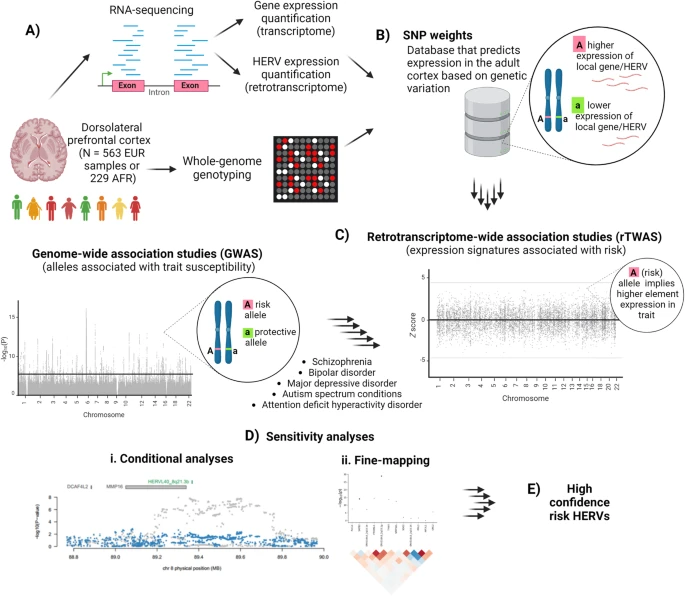HERVs UNMASKED: GENETIC CLUES TO PSYCHIATRIC DISORDERS
In this study, researchers analyzed the dorsolateral prefrontal cortex (DLPFC), a brain region implicated in psychiatric disorders. After several analyses, including conditional analyses, rTWAS fine-mapping, sensitivity analyses, co-expression network analysis, and genomic context, the researcher identified 26 HERV expressions associated with susceptibility to various psychiatric disorders. The significant HERV signals were found in the Major Histocompatibility Complex (MHC) on chromosomes ERV316A3_6p22.1b and ERV316A3_2q33.1g. Significant HERV for bipolar expression was found in MER4_20q13.13 and PRIMA41_9q34. HERVs for major depressive disorder (MMD) were located on chromosomes 1p31, 9p23, 3p21, and 14q24. For ADHD, seven expression signatures were identified, but none were HERVs. Only one expression signature was associated with autism spectrum conditions, and it was not a HERV. Interestingly, one HERV (MER4_20q13.13) was associated with both schizophrenia and bipolar disorder. Another key finding includes the biological function and the regulatory mechanism. It is found that HERVs are not randomly distributed but grouped into modules within canonical genes. It is also found that HERV can influence gene expression
Fig. 1: A summary of the retrotranscriptome-wide association study (rTWAS) approach
The meticulous methodology of the study, involving advanced RNA sequencing, precise HERV quantification, and robust statistical analysis, underscores the potential of HERVs as significant factors in psychiatric disorders. By leveraging the rich CommonMind Consortium dataset and employing sophisticated bioinformatics tools, the research provides crucial insights into the complex genetic architecture of psychiatric conditions. This comprehensive analysis framework, encompassing data normalization, SNP weight construction, rTWAS, secondary analyses, network analysis, and gene ontology interpretation, offers a detailed understanding of the genetic and transcriptomic landscape underlying psychiatric disorders. The approach enabled the integration of diverse genetic data across different populations, ensuring robust and translatable findings.
Refrence
Image source:



Comments
Post a Comment